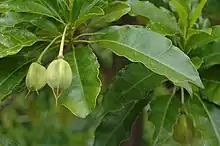Peripentadenia
Peripentadenia is a genus of two species of large trees from the family Elaeocarpaceae endemic to the rainforests of northeastern Queensland, Australia.[2][3][4][5][6] Sometimes they have the common name quandong.[4][7]
| Peripentadenia | |
|---|---|
 | |
| Peripentadenia mearsii | |
| Scientific classification | |
| Kingdom: | Plantae |
| Clade: | Tracheophytes |
| Clade: | Angiosperms |
| Clade: | Eudicots |
| Clade: | Rosids |
| Order: | Oxalidales |
| Family: | Elaeocarpaceae |
| Genus: | Peripentadenia L.S.Sm.[1][2] |
| Type species | |
| Peripentadenia mearsii | |
| Species | |
|
See text | |
Botanists have formally described two species, both endemic to restricted areas of the Wet Tropics rainforests of northeastern Queensland.[2][3][4][7][8]
Both species have official recognition of at risk of extinction in the wild.[9]
Species
- Peripentadenia mearsii (C.T.White) L.S.Sm.[1] Buff or Grey Quandong – endemic to a restricted area of the Wet Tropics rainforests[4][5][7]
- Synonym and base name: Actephila mearsii C.T.White
- Queensland government official "near threatened" species conservation status.[9]: 73
- Peripentadenia phelpsii B.Hyland & Coode[5] – endemic to a very restricted part of the rainforests of the Mossman area of the Wet Tropics[4][8]
- Queensland government official "vulnerable" species conservation status.[9]: 54
References
- Smith, Lindsay S. (1957). "New species of and notes on Queensland plants - II". Proceedings of the Royal Society of Queensland. 68: (43–) 45–50. Retrieved 10 January 2014.
- "Peripentadenia%". Australian Plant Name Index (APNI), Integrated Botanical Information System (IBIS) database (listing by % wildcard matching of all taxa relevant to Australia). Centre for Plant Biodiversity Research, Australian Government. Retrieved 10 January 2014.
- F.A.Zich; B.P.M.Hyland; T.Whiffen; R.A.Kerrigan (2020). "Elaeocarpaceae". Australian Tropical Rainforest Plants Edition 8 (RFK8). Centre for Australian National Biodiversity Research (CANBR), Australian Government. Retrieved 21 June 2021.
- Cooper, Wendy; Cooper, William T. (June 2004). Fruits of the Australian Tropical Rainforest. Clifton Hill, Victoria, Australia: Nokomis Editions. p. 163. ISBN 9780958174213. Retrieved 21 June 2021.
- Hyland, Bernie P. M.; Coode, Mark J. E. (1982). "A second species for the Australian genus Peripentadenia (Elaeocarpaceae)". Kew Bulletin. 36 (4). pp. 741–745, figs 1-2. doi:10.2307/4117917. JSTOR 4117917.
- Coode, Mark J. E. (1987). "Crinodendron, Dubouzetia and Peripentadenia, closely related in Elaeocarpaceae". Kew Bulletin. 42 (4). pp. (777–) 812-813 (–814), fig. 14. doi:10.2307/4109929. JSTOR 4109929.
- F.A.Zich; B.P.M.Hyland; T.Whiffen; R.A.Kerrigan (2020). "Peripentadenia mearsii". Australian Tropical Rainforest Plants Edition 8 (RFK8). Centre for Australian National Biodiversity Research (CANBR), Australian Government. Retrieved 21 June 2021.
- F.A.Zich; B.P.M.Hyland; T.Whiffen; R.A.Kerrigan (2020). "Peripentadenia phelpsii". Australian Tropical Rainforest Plants Edition 8 (RFK8). Centre for Australian National Biodiversity Research (CANBR), Australian Government. Retrieved 21 June 2021.
- Queensland Government (27 September 2013). "Nature Conservation (Wildlife) Regulation 2006" (PDF). Nature Conservation Act 1992. Online, accessed from www.legislation.qld.gov.au. Australia. Retrieved 14 December 2013.
Cited works
- F.A.Zich; B.P.M.Hyland; T.Whiffen; R.A.Kerrigan (2020). "Australian Tropical Rainforest Plants Home". Australian Tropical Rainforest Plants Edition 8 (RFK8). Centre for Australian National Biodiversity Research (CANBR), Australian Government. Retrieved 21 June 2021.
This article is issued from Wikipedia. The text is licensed under Creative Commons - Attribution - Sharealike. Additional terms may apply for the media files.